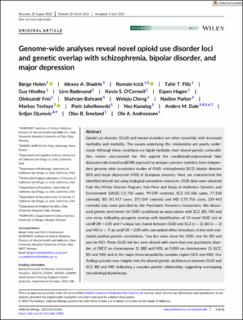| dc.contributor.author | Holen, Børge | |
| dc.contributor.author | Shadrin, Alexey | |
| dc.contributor.author | Icick, Romain | |
| dc.contributor.author | Filiz, Tahir Tekin | |
| dc.contributor.author | Hindley, Guy Frederick Lanyon | |
| dc.contributor.author | Rødevand, Linn | |
| dc.contributor.author | O'Connell, Kevin Sean | |
| dc.contributor.author | Hagen, Espen | |
| dc.contributor.author | Frei, Oleksandr | |
| dc.contributor.author | Bahrami, Shahram | |
| dc.contributor.author | Cheng, Weiqiu | |
| dc.contributor.author | Parker, Nadine | |
| dc.contributor.author | Woldeyohannes, Markos Tesfaye | |
| dc.contributor.author | Jaholkowski, Piotr Pawel | |
| dc.contributor.author | Karadag, Naz | |
| dc.contributor.author | Dale, Anders M | |
| dc.contributor.author | Djurovic, Srdjan | |
| dc.contributor.author | Smeland, Olav Bjerkehagen | |
| dc.contributor.author | Andreassen, Ole | |
| dc.date.accessioned | 2023-10-05T13:32:34Z | |
| dc.date.available | 2023-10-05T13:32:34Z | |
| dc.date.created | 2023-06-20T09:24:59Z | |
| dc.date.issued | 2023 | |
| dc.identifier.issn | 1355-6215 | |
| dc.identifier.uri | https://hdl.handle.net/11250/3094550 | |
| dc.description.abstract | Opioid use disorder (OUD) and mental disorders are often comorbid, with increased morbidity and mortality. The causes underlying this relationship are poorly understood. Although these conditions are highly heritable, their shared genetic vulnerabilities remain unaccounted for. We applied the conditional/conjunctional false discovery rate (cond/conjFDR) approach to analyse summary statistics from independent genome wide association studies of OUD, schizophrenia (SCZ), bipolar disorder (BD) and major depression (MD) of European ancestry. Next, we characterized the identified shared loci using biological annotation resources. OUD data were obtained from the Million Veteran Program, Yale-Penn and Study of Addiction: Genetics and Environment (SAGE) (15 756 cases, 99 039 controls). SCZ (53 386 cases, 77 258 controls), BD (41 917 cases, 371 549 controls) and MD (170 756 cases, 329 443 controls) data were provided by the Psychiatric Genomics Consortium. We discovered genetic enrichment for OUD conditional on associations with SCZ, BD, MD and vice versa, indicating polygenic overlap with identification of 14 novel OUD loci at condFDR < 0.05 and 7 unique loci shared between OUD and SCZ (n = 2), BD (n = 2) and MD (n = 7) at conjFDR < 0.05 with concordant effect directions, in line with estimated positive genetic correlations. Two loci were novel for OUD, one for BD and one for MD. Three OUD risk loci were shared with more than one psychiatric disorder, at DRD2 on chromosome 11 (BD and MD), at FURIN on chromosome 15 (SCZ, BD and MD) and at the major histocompatibility complex region (SCZ and MD). Our findings provide new insights into the shared genetic architecture between OUD and SCZ, BD and MD, indicating a complex genetic relationship, suggesting overlapping neurobiological pathways. | en_US |
| dc.language.iso | eng | en_US |
| dc.publisher | Wiley | en_US |
| dc.rights | Navngivelse-Ikkekommersiell 4.0 Internasjonal | * |
| dc.rights.uri | http://creativecommons.org/licenses/by-nc/4.0/deed.no | * |
| dc.title | Genome-wide analyses reveal novel opioid use disorder loci and genetic overlap with schizophrenia, bipolar disorder, and major depression | en_US |
| dc.type | Journal article | en_US |
| dc.type | Peer reviewed | en_US |
| dc.description.version | publishedVersion | en_US |
| dc.rights.holder | Copyright 2023 the authors | en_US |
| dc.source.articlenumber | e13282 | en_US |
| cristin.ispublished | true | |
| cristin.fulltext | original | |
| cristin.qualitycode | 1 | |
| dc.identifier.doi | 10.1111/adb.13282 | |
| dc.identifier.cristin | 2156051 | |
| dc.source.journal | Addiction Biology | en_US |
| dc.identifier.citation | Addiction Biology. 2023, 28 (6), e13282. | en_US |
| dc.source.volume | 28 | en_US |
| dc.source.issue | 6 | en_US |

